Medical Gas Systems
Bulk oxygen systems, compressed gas cylinders, regulators and flowmeters, and oxygen concentrators are featured.


Compressed Gas Cylinders
This section of the gallery focuses on compressed gas cylinders.


1904 Receipt for Oxygen
This receipt from 1904 indicates that 200 gallons of oxygen were sold by the American Oxygen Associaton to the New England Hospital for $10.00.
Image from Steve and Mary DeGenaro


1909 Receipt for Empty Cylinder
This 1909 receipt from the Standard Oxygen Company acknowledged the return of an empty oxygen cylinder.
Image from Steve and Mary DeGenaro


1918 J.A. Steinmetz’s Patent for Protected Gas Cylinders
The cylinder protectors were used in WWI to reduce the noise of cylinders banging against each other when they used near enemy lines. The device also eased lifting and transporting the cylinders.
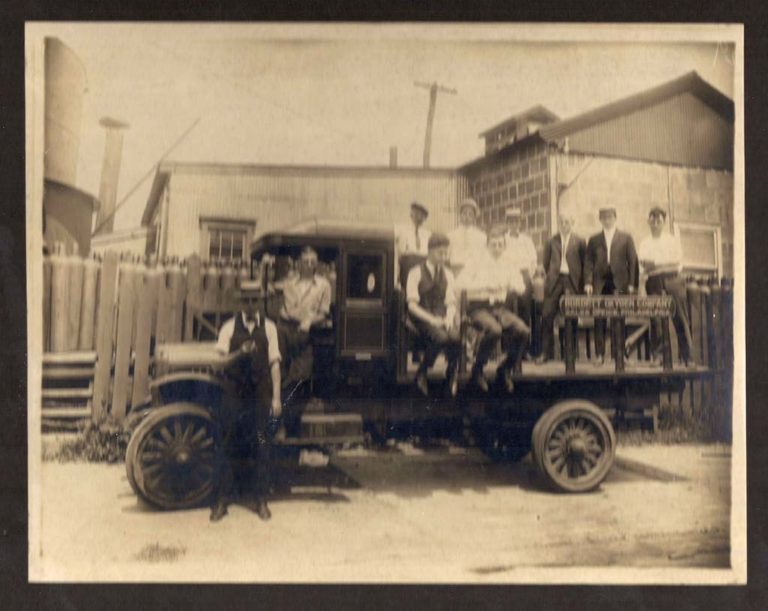

1920 Oxygen Cylinder Delivery Truck
This photo from 1920 shows the staff of an oxygen company with their delivery truck. The numerous cylinders on the deck and leaning against the wall of the building all appear to be unsecured.
Image from Steve and Mary DeGenaro


1940s E Cylinder Manufacture and Retest Dates
The shoulder stampings on this cylinder indicate it was manufactured in August 1935 and that it passed retests in 1940 and 1945.
Image from Kerry George


1940s Oxygen Cylinder
A vintage oxygen cylinder from the 1940s is pictured.
Image from Kerry George


1940s Oxygen Orderlies
Piped-in oxygen was not a reality in the early years of our profession. The responsibility for transporting the large oxygen cylinders to the designated areas of the hospital fell upon the staff of the inhalation therapy departments, earning them the nickname of "tank jockey".


1950s Oxy-hale Pocket Oxygen Dispenser
This Oxy-hale ad from an early issue of INHALATION THERAPY was for a portable oxygen dispenser that could be transported in one's pocket.


1951 Oxygen Therapy Department
This 1951 photo shows a staff member from the inhalation therapy department of St. Francis Hospital in Peoria, Illinois returning a cylinder to the department.
Image from Joseph Witherspoon


1950s Oxygen Inhalator
This ad from an early issue of INHALATION THERAPY was for an "oxygen inhalator kit". The portable cylinder supplied 15 minutes of oxygen. The ad indicated it was "impossible to inhale overdose" due to the unit's patented control gauge.

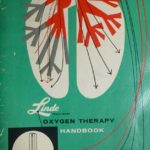
Linde Handbook
Linde was one of the major oxygen suppliers in the 1950s and 1960s. This photo shows the cover of Linde's Oxygen Therapy handbook supplied to inhalation therapy departments.
Image from Felix Khusid
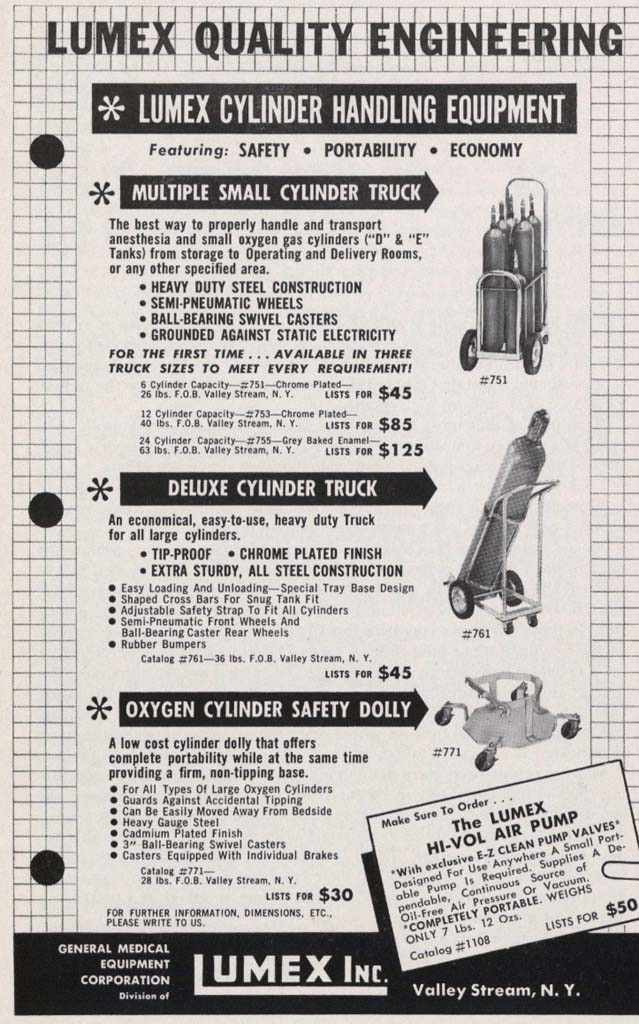

Cylinder Trucks and Dollies
This ad for cylinder trucks and dollies appeared in the March 1958 issue of the INHALATION THERAPY journal.


1960s OxySwig Emergency Oxygen Kit
This ad from an early 1960s issue of INHALATION THERAPY shows the Oxy-Swig kit for emergency use of oxygen. The refillable device weighed 4 pounds and contained 45 liters of oxygen.


1960s Breath-O-Life
The Breath-O2-Life sphere manufactured in Cleveland, Ohio contained one hour of "pure medical oxygen."


1960s Portable Oxygen Spheres
This emergency oxygen kit from Safety Laboratories contained two oxygen spheres.
Image from Tony Ruppert


1960 Oxy-Aid Portable Oxygen
This emergency oxygen kit from the 1960s was supplied in its own small suitcase. The brochure indicates the oxygen supply would last for 12 minutes.
Image from Deb Skees


1960 Oxy-Aid Brochure
The Oxy-Aid brochure the emergency oxygen kit could be used for "day or nite" for heart conditions, stroke, asphyxia, drwonng, asthma attacks, coma, fatigue, driving exhaustion, and migaine headaches.
Image from Deb Skees


Oxy-Lyfe Dual Oxygen Unit
This portable dual cylinder unit, "supplied in a beautiful luggage case" had a capacity of 600 liters of oxygen and could serve two people at the same time.
Image from Felix Khusid


1970s Cylinder with Bourdon Gauge
This cylinder is shown with an attached Bourdon gauge flowmeter.
Image from Rusty Taylor


Cylinder Wrench
A wrench was essential to open and close the valve on a small cylinder.
Image from Illinois Central College Archives, 1999


2000s E Cylinder Storage Cart
A large storage cart filled with full E cylinders is shown.
Image from Bill Baker


2000s Cylinder Storage Room
An oxygen cylinder storage room with multiple sizes of cylinders is shown.
Image from Bill Baker


2000s Compressed Gas Cylinders
This image from the early 2000s shows 11 sizes of oxygen cylinders.
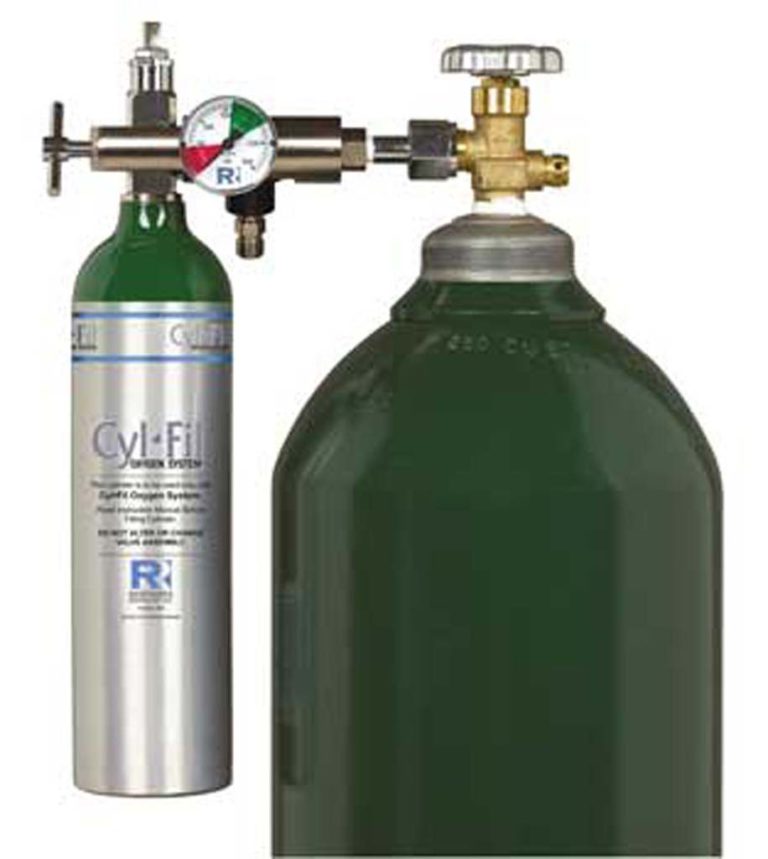

2000s Trans-fillable Oxygen Cylinder
A trans-fillable oxygen system is shown to fill a small portable cylinder from a larger compressed oxygen cylinder.


E Cylinder Label
A 2014 label for an E cylinder is shown.
Image from Bill Baker


Medical Gas Mixtures
Medical gas mixtures are featured in this section of the gallery.


Circa 1920 5% Carbon dioxide – 95% Oxygen Mixture
This photo shows a mixture of 95% oxygen and 5% carbon dioxide being administered via a resuscitator. This compressed gas mixture is sometimes referred to as carbogen.
Image from Steve and Mary DeGenaro


80% Helium and 20% Oxygen via Oxygen Hood
This photo from the 1940s shows a patient receiving an "80-20" mixture of helium and oxygen via an oxygen hood.
Image from Dennis Glover
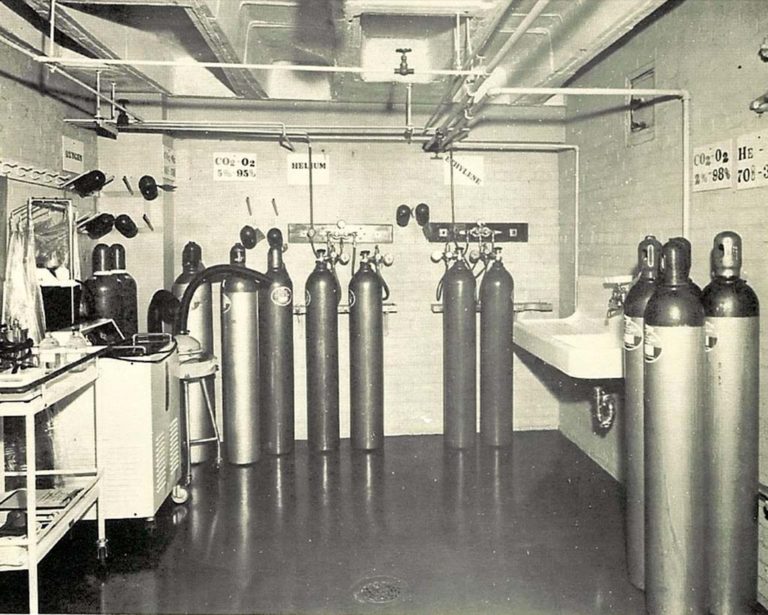

1951 Medical Gas Mixture Storage in an Oxygen Department
This photo shows the compressed gas storage room with specific spots for different gas mixtures clearly labeled, that supplied the operating rooms at St. Francis Hospital, Peoria, Illinois in 1951.
Image from Joseph Witherspoon


1995 Nitric Oxide with HFOV in the NICU
This photo shows a cylinder of nitric oxide used in conjunction with a high frequency oscillator in a neonatal intensive care unit .
Image from Lucy Linder

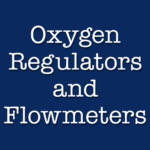
Oxygen Regulators and Flowmeters
Oxygen flowmeters and regulators are featured in this section.


1913 Test Gauge
This nickel-plated, brass medical test gauge is stamped "Made for Dr. W.A. Drysdale by the Star Brass Manufacturing Company of Boston, MA. The gauge has a lever valve and thumb wheel for controlling air pressure.
Image from Felix Khusid


1913 Regulator
The nitrous oxide regulator shown was manufactured in June 1913 as evidenced by a date stamp on the regulator manufactured by the Lennox Chemical Company, Cleveland, Ohio.
Image from Felix Khusid


1940s Oxygen Regulator
A large oxygen cylinder regulator with flowmeter from the 1940s is shown.
Image from Dennis Glover


Heliox Regulator
A Puritan Compressed Gas Company regulator, circa 1943, designed for the administration of 80%-20% helium-oxygen mixtures is shown.
Image from Felix Khusid


1950s Yoke Regulator
This ad for yoke regulators from National Medical Equipment appeared in an early issue of INHALATION THERAPY journal.


1950s Victor Regulator
A regulator manufactured by Victor for use on small cylinders is shown.
Image from Glenn Tammen


1950s Regulator
This ad for an oxygen cylinder regulator from the Liquid Carbonic Corporation appeared in an early issue of the INHALATION THERAPY journal.


1951 Flowmeter and Oxygen Tubing
St. Francis Hospital in Peoria, Illinois was one of the first in the country to have piped-in oxygen in a section of the facility. This photo from 1951 shows a flowmeter attached to the wall outlet. Note the exposed piping on the wall and the rubber delivery tubing from the flowmeter.
Image from Joseph Witherspoon
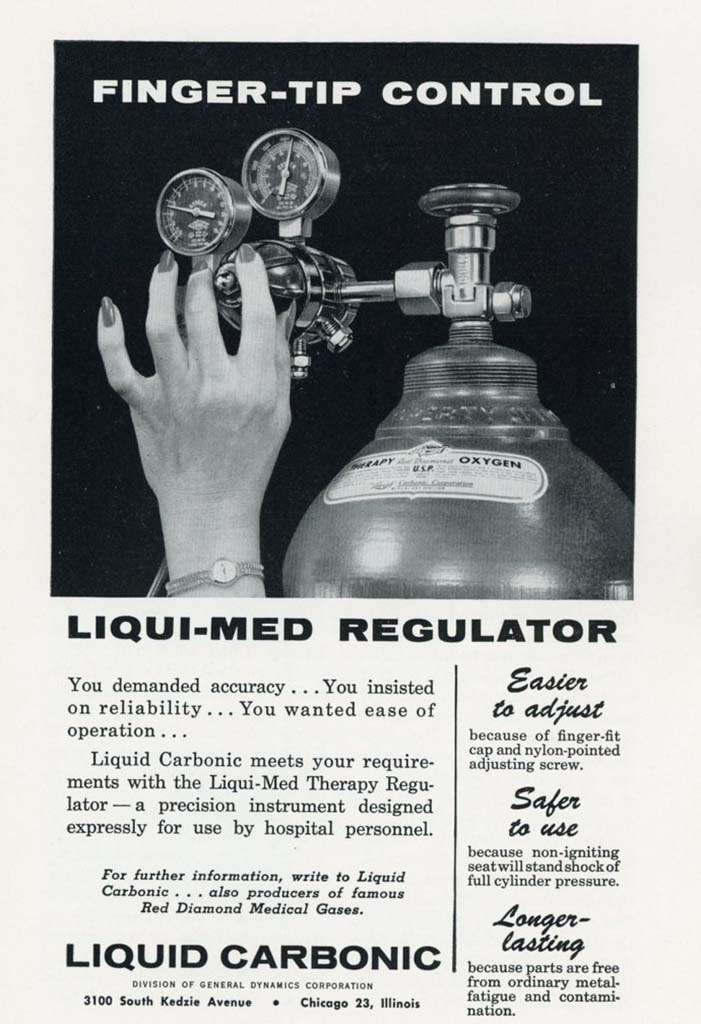

1960s Liqui-Med Regulator
This ad for a "Liqui-Med Therapy Regulator" for oxygen oxygen cylinders appeared in an issue of the INHALATION THERAPY journal in the early 1960s.


1960s Puritan Regulator
An INHALATION THERAPY journal ad from the 1960s for Puritan's cylinder regulator and flowmeter is shown.


1960s Puritan Washer
This ad for the Puritan washer to prevent leaks on small cylinders appeared in a 1960s issue of the INHALATION THERAPY journal.


NCG Flowmeters
Two flowmeters from National Cylinder Gas (NCG) are shown.
Image from Robert Johnson


1970s Ohio Oxygen Flowmeter
An oxygen flowmeter by Ohio Medical is shown in the off position in a wall outlet.
Image from Glenn Tammen


1980s NCG Flowmeter and Chemtron Wall mount
A Chemtron wall mount and connector for oxygen and a NCG flowmeter are shown.
Image from Karen Schell


1951 Oxygen Charge Slip
Before meters that recorded oxygen usage were invented, staff in the inhalation therapy and oxygen departments manually calculated the patients' oxygen usage and submitted charges to the hospital billing office.
Image from Joseph Witherspoon


1951 Oxygen Therapy Department
The bulletin boards behind the therapist identify all of the oxygen set-ups in the hospital. Notice the flowmeters, regulators, and related equipment on the shelves.
Image from Joseph Witherspoon


1960s Ohio Chemical's Totalizing Flowmeter
This ad for Ohio Chemical's "Totalizing Flowmeter" appeared in an 9160s issue of the INHALATION THERAPY journal. the flowmeter had an attached meter that tracked the liters of oxygen used.


1970s Timeter
This ad for the Timeter Oxygen Flow Timer appeared in a 1970s issue of the RESPIRATORY CARE journal. The unit attached to the outlet of the oxygen flowmeter and recorded the hours that oxygen was administered.


1980s Timemeter TimeaTron
A Timeter Timeatron connected below a flowmeter and digitally displayed the hours of oxygen use.
Image from Karen Schell


2000s Intermittent Flow Regulators
A collection of intermittent flow regulators and pulse dose regulators are displayed.

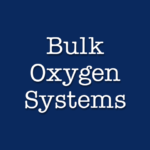
Bulk Oxygen Systems
A bulk O2 system is defined as one with a storage capacity with > 13,000 cubic feet of oxygen connected and ready for use or 25,000 cubic feet of oxygen available on site.
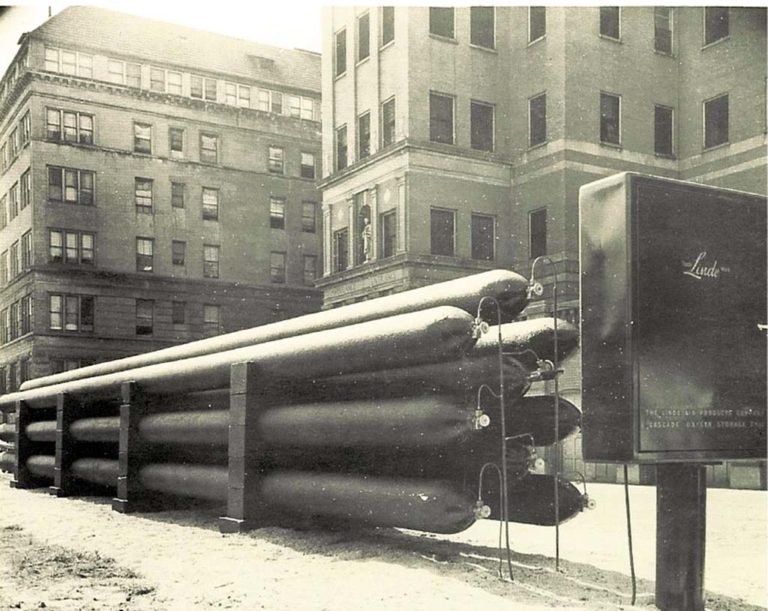

1951 Long Cylinders (41 Feet in Length) Supplied The Hospital Piping System
This 1951 photo from St. Francis Hospital in Peoria, Illinois shows the 41 ft. long, refillable oxygen cylinders that were used to supply the hospital's piped-in oxygen.
Image from Joseph Witherspoon
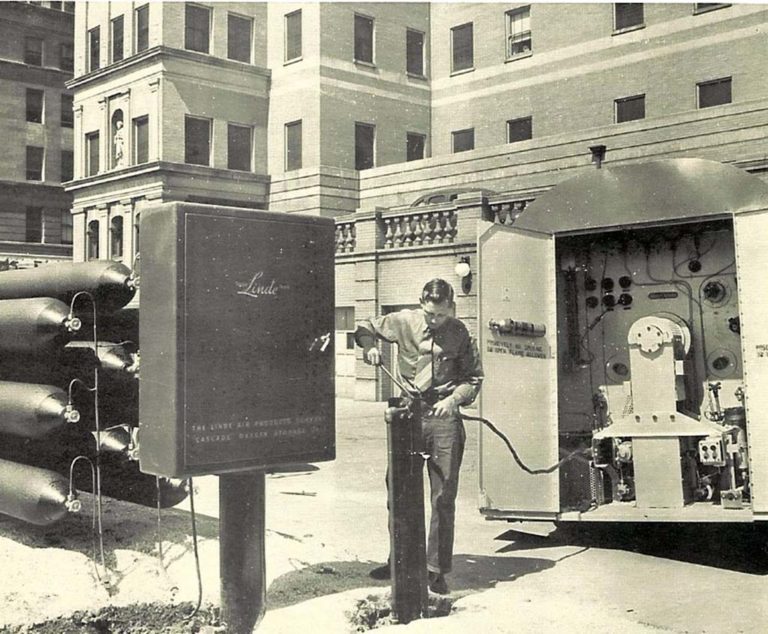

1951 Refilling the Long Cylinders
This photo from 1951 shows the Linde technician preparing to refill the long cylinders at St. Francis Hospital in Peoria, Illinois.
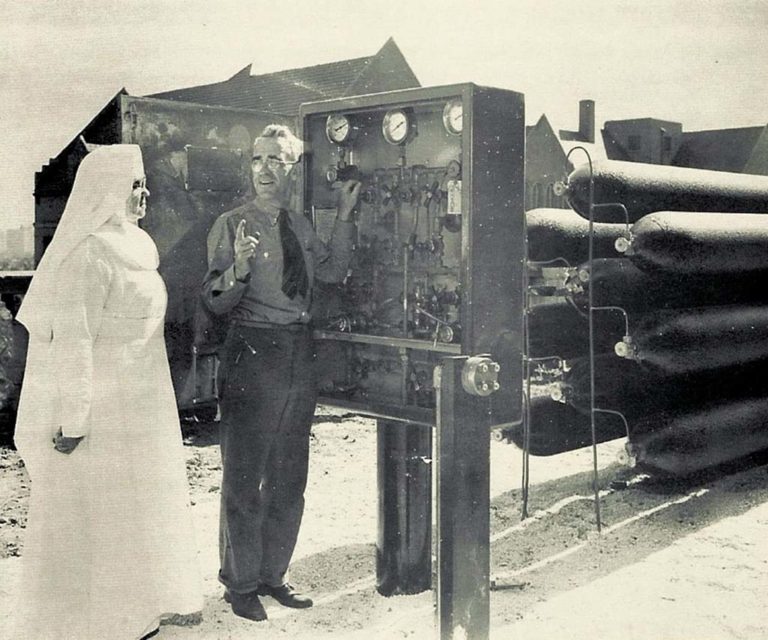

1951 Reviewing the Operation of the Bulk System
This photo shows the Linde technician reviewing the operation of the bulk oxygen system with the nun who was the director of the inhalation therapy department at St. Francis Hospital in Peoria Illinois in 1951.
Image from Joseph Witherspoon


1951 Piped-In Oxygen in a Patient Room
The piped-in oxygen in a patient room in 1951 at St. Francis Hospital in Peoria Illinois is shown.
Image from Joseph Witherspoon


1951 Piped-In Oxygen Wall Outlet
A close up of the oxygen outlet in a patient room at St. Francis Hospital in Peoria, Illinois in 1951 is shown.
Image from Joseph Witherspoon
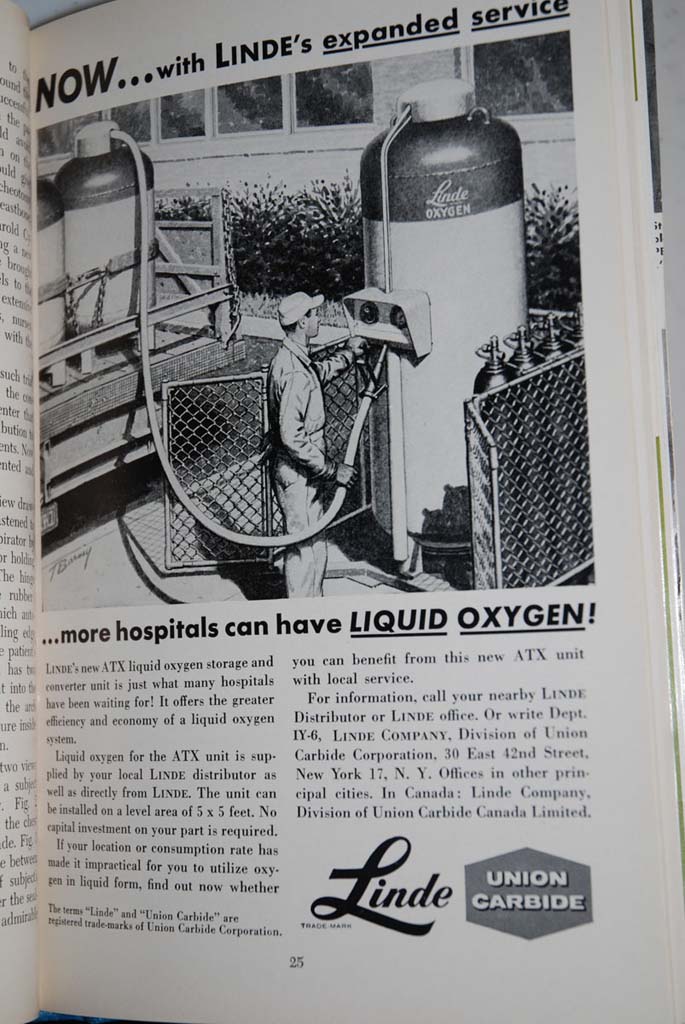

1960s Linde's Bulk Liquid Oxygen System
This ad for Linde's bulk oxygen system appeared in a 1960's issue of the INHALATION THERAPY journal.


1990s Bulk Liquid Oxygen System
This 1990s photo shows the storage tanks and vaporizers of a bulk oxygen system.


1951 Banks of Manifolded Cylinders
This vintage photo shows banks of cylinders connected together via a manifold system.
Image from Joseph Witherspoon


1961 Manifold System Patent
B.H. Acomb's Patent for "Automatic Changeover Manifold" was granted in January 1961.


Cylinder Manifold System
A modern cylinder manifold system is shown.
Image from Bill Baker


Oxygen - Air Blenders and Diluters
This section of the gallery features oxygen-air blenders and diluters.


1940s Oxygen Diluter Attached to Cylinder Regulator
In this 1940s photo, a diluter is shown placed between the outlet of the cylinder regulator and the oxygen delivery tubing.
Image from Dennis Glover


1950s Ohio Oxygen Diluter
In this Ohio Chemical ad from a 1950s issue of the INHALATION THERAPY journal, an oxygen diluter is shown in the lower portion. The diluter was designed for use with the Ohio 100 non-rebreathing mask and was adjustable between FIO2 0.40-0.90.


Resp-Aid Diluter
The Resp-Aid diluter was used in the 1950s-1960s and offered seven FIO2s: 0.32, 0.34, 0.37, 0.41, 0.50, 0.60, or 0.95.
Image from Felix Khusid


1975 Bird Blender Patent
Forrest M. Bird and Henry L. Pohndorf were the inventors of the oxygen-air blender which was patented on July 22, 1975.
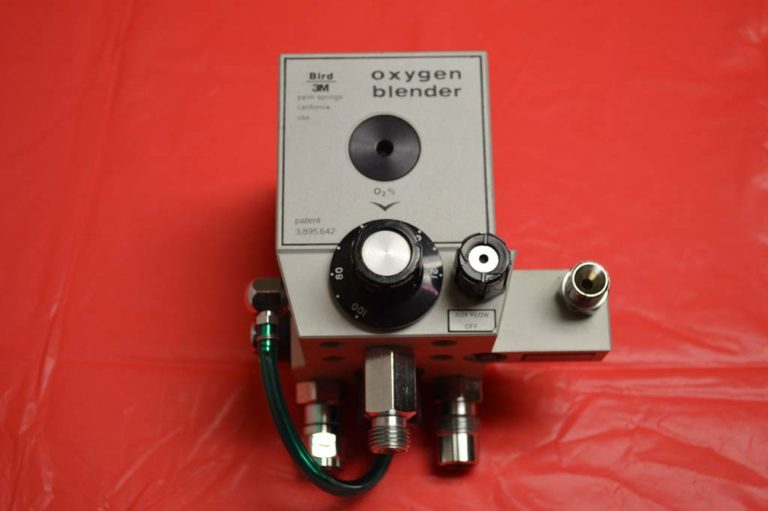

1980s Bird Oxygen Blender
A Bird oxygen blender from the 1980s is shown.
Image from Karen Schell


Blenders
Three oxygen blenders are shown: Ohio, Bird, and Veriflo
Image from Felix Khusid


Blenders and Proportioners
An assortment of oxygen blenders and proportioners are shown.
Image from Gregory Rittenhouse


1990s Siemens Oxygen-Air Blender
A Siemens Oxygen-Air Mixer Model 965 is shown.
Image from Illinois Central College Archives, 1999


1990s Maxblend Low Flow Air Blender
A Maxblend low flow, oxygen air blender is shown.
Image from Karen Schell


Oxygen Concentrators and Home LOX
Oxygen concentrators and liquid oxygen systems for home care are featured in this section
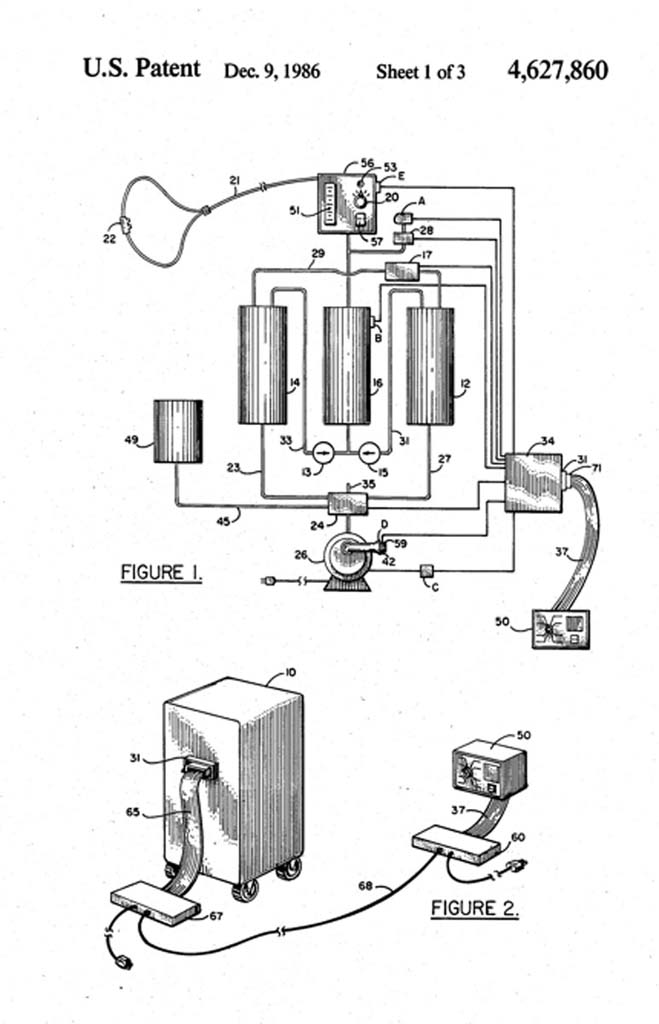

1986 Patent for Bendix Molecular Sieve Concentrator
Bendix Corporation's Respiratory Support System, was a molecular sieve concentrator.


Stationary Concentrators
Three stationary oxygen concentrators are shown in this 2014 photo.


2000s Portable Concentrators
Some of the early portable concentrators were equivalent in size to rolling, carry-on luggage.

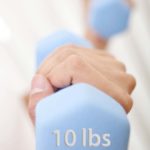
2002 POCs less than 10 pounds
Dr. Tom Petty had long recommended that portable oxygen concentrators (POCs) should ideally weigh less than 10 pounds. Since that goal was first achieved in 2002, POCs have continued to become more lightweight. Some models currently available weigh less than 5 pounds.


FAA-approved portable concentrators
Since 2009, passengers requiring oxygen may use FAA-approved portable concentrators on most commercial flights. Passengers with POCs must give advance notification to the airline of their intent to travel with POCs, as well as present their prescription for oxygen and their release for air travel from their physicians.


Refillable Portable System
A patient is shown refilling a portable unit from a stationary liquid oxygen reservoir in her home.
Image from Barry Make, MD


Portable
An patient is shown using her portable oxygen system.
Image from Barry Make, MD
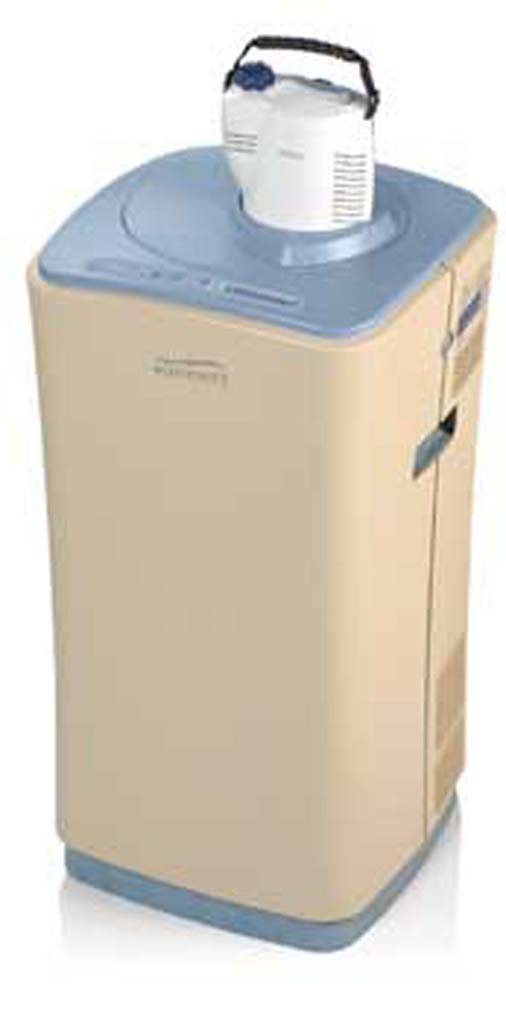

Respironics HomeLOX
The Respironics HomeLOX combines a concentrator, liquid dewar, and refillable portable device called the GoLox in one unit. The portable GoLox weighs less than 4 pounds while the stationary reservoir weighs approximately 100 pounds.


Modern Liquid Oxygen Home Systems
A variety of liquid oxygen reservoirs and portable units are shown.


Images to share?
If you have images to share, please follow the instructions for photo contributors.